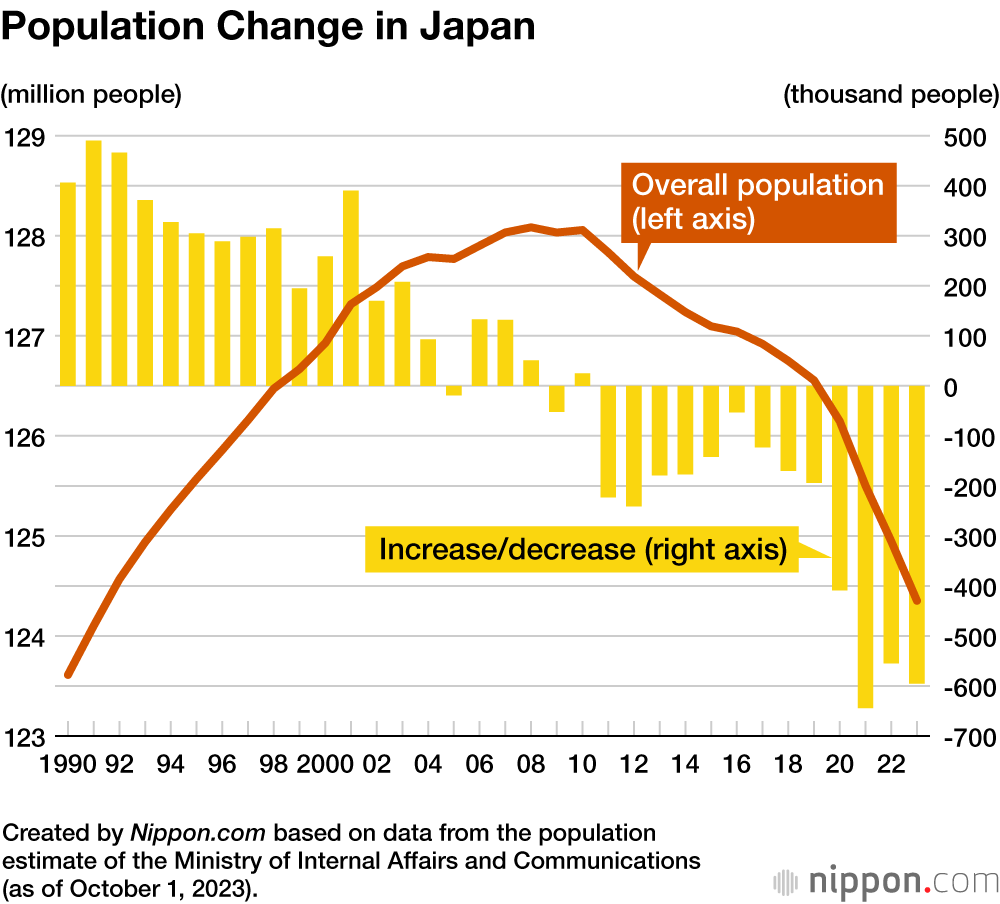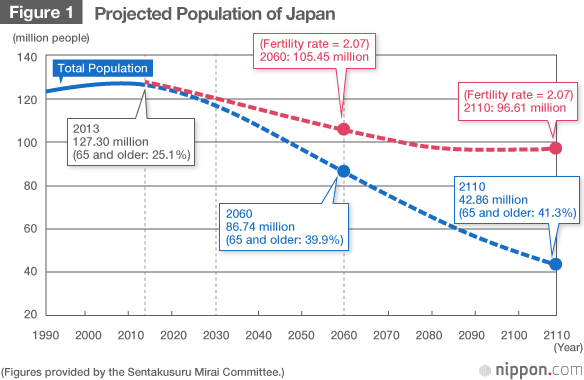Japan has one of the oldest populations in the world, with over 28% of its people aged 65 or older. At the same time, the birth rate is low, and the population is shrinking. This creates significant challenges, like worker shortages, rising healthcare costs, and struggling small towns. To deal with these changes, Japan is using new technology, encouraging older people to keep working, and adjusting its policies. As the population continues to decline, the country must find new ways to adapt and thrive. Moreover, these effects are also relevant to international schools in Japan, as they may affect the overall student population.

Japan is facing a serious demographic challenge. The population is steadily shrinking, and the birth rate has dropped to around 1.3, far below the level needed to maintain a stable population. As a result, there are fewer young people, while the proportion of elderly citizens continues to rise. Since the 2010s, Japan’s population has steadily decreased, reaching half the rate of the 1990s. This shift is also relevant to international communities, as a smaller population means fewer students for international schools, such as St. Mary’s International School.

A significant reason for Japan’s aging population lies within the social expectations of workplace culture that are put onto society. Because of job stress, long working hours, and the high cost of living, many people in Japan delay marriage and avoid having children. Women face these challenges the most, as they have to balance a career and family life due to gender roles in society and limited child care. As a result of this, many women in Japan have fewer children than they want, or they just avoid having children completely. Additionally, the urban lifestyle in Japan makes raising children even more expensive and difficult. Therefore,

The shortage of workers is the biggest effect of Japan’s aging population. Since fewer young people and more old people, not enough young people enter the workforce. This leads to a lack of people to fill jobs that are key in society, such as healthcare, construction, and manufacturing. This is the cause of many companies struggling and relying more on machines or foreign workers. As shown in the graph to the left, the average age in the country will continue to increase, with fewer younger people to fill the economic labor force of Japan.
Furthermore, economically, Japan is facing rising costs of healthcare and pensions since there are more older people who need public support and fewer young people who are paying taxes. In addition to this, rural areas, which are areas outside of towns or cities, are being affected significantly. Many young people move to bigger cities for education and jobs, which causes the already small town to lose population. This makes the rural towns shrink in population, close schools, and abandon homes.

The UN World Population Prospects suggests that by 2050, Japan’s population may fall to around 100 million, drastically reshaping the nation’s social and economic landscape. As Japan faces this crisis, labor shortages remains the biggest concern of Japan’s aging population.
The National Institute of Population and Social Security Research states that the working-age population from the ages of 15 to 64 decreased 15% between 1995 and 2023—a number that will surely continue to go down without a feasible solution. As Japan’s labor force continues to decline, it is projected that by 2040, the country will lack over 11 million workers.
Due to the shrinking of the labor force, Japan has subsequently seen an increasing scarcity of key jobs in healthcare, construction, and manufacturing, especially. These sectors face the most intense labor shortages in the nation, with construction workers even grappling with a jobs-to-applicants ratio of 5.60, meaning that there are about 5.6 job openings for every one person applying. While the labor shortages of certain industries are the most pressing, Japan as a whole is experiencing the lowest labor productivity of all G7 countries, producing the lowest number of GDP from national workers in comparison to Canada, Germany, the United States, France, Italy, and the United Kingdom. Evident with Japan’s 2024 loss as the third largest economy to Germany, the country’s national income is seeing a monumental decline.
Further adding to the challenges, while Japan’s working-age population and thus national income shrinks, the number of elderly who receive pension payments is increasing at a faster rate than ever, increasingly pressuring the nation’s labor market and social security system. Japan spends an estimated 16% of its national income on social security—an absolutely enormous number compared to other G7 nations like the United States, which spends only around 5%. While 16% is already an exceptionally large number, that figure is only projected to rise continuously as the number of elderly people to support grow, but the number of people making money to support them shrink.
With the labor force shrinking, the need for social security increasing, and no successful solution implemented by the government, many elderly have begun to brace for a possible future without retirement.
According to the World Economic Forum, surveys indicate that approximately 80% of Japanese workers would want to continue working after retirement. Nevertheless, the current age of retirement for the majority of Japanese corporations is 65, and there are still significant barriers to senior employment. It is regulated by Japanese law that once a person reaches the age of 60 and their combined salary and pension extends a certain amount, their pensions are reduced. Companies avoid this situation by reducing salaries for seniors, which consequentially leads to major wage reduction and an obstacle for seniors to acquire secure employment.
Discussions have been held on whether to extend the senior retirement threshold, and the Japanese government has responded through the Revised Law Concerning Stabilization of Employment of Older Persons where companies are obliged to extend the retirement age for their employees. With the Japanese government officially encouraging older citizens to remain in the workforce, leading Japanese companies such as Daikin have already shifted their policies so that senior citizens can work until the age of 70, ensuring secure employment for all.
Another potential solution regarding labor shortages in Japan is through the development of technology. Hiroko Akiyama, a professor at the University of Tokyo’s Institute of Gerontology, claims that “aging societies have the potential for innovation.” In industrial sectors of transportation, agriculture, and construction — all of which are significantly impacted by Japan’s rapidly aging population — the government is investing heavily in technologies that will support the aging workforce and perhaps gradually work towards substituting human labor.
Currently, the Japanese agricultural industry has the most needs as well as the potential for innovation. In 2022, 70 percent of farmers were above age sixty-five. To combat the issue of an aging farming population, the Japanese government is actively promoting the use of IT in farming. Also dubbed as the “Smart Agriculture Project,” the program aims to increase the automation of tasks through robotic tractors, drones, and use of AI tools for data gathering and optimization of crop growth. This would enable inexperienced personnel to be able to operate agricultural processes, greatly contributing to the farming industry.
Moreover, the Japanese government has begun encouraging older citizens to remain in the workforce. The current age of retirement for the majority of Japanese corporations is 65, but discussions have been held on whether to extend this threshold — or abandon it altogether. According to the World Economic Forum, surveys indicate that approximately 80% of Japanese workers would want to continue working after retirement. Nevertheless, there are barriers to senior employment, with the predominant issue being wage reduction. It is regulated by Japanese law that once a person reaches the age of 60 and their combined salary and pension extends a certain amount, their pensions are reduced. Companies avoid this situation by reducing salaries for seniors, which becomes a major obstacle for them to advance within the work force.
Ultimately, it is important for the Japanese government to find a balance between employing senior citizens and investing in automation to address the shrinking labor force. As the working population continues to decline, a collaboration between both human and technological resources is essential to address the socioeconomic challenges that will result from Japan’s aging society.
In confusion, Japan’s aging population is an issue for Japanese society and the international community. The Japanese government and the international community must provide clear solutions to combat the detriments that follow an aging population.